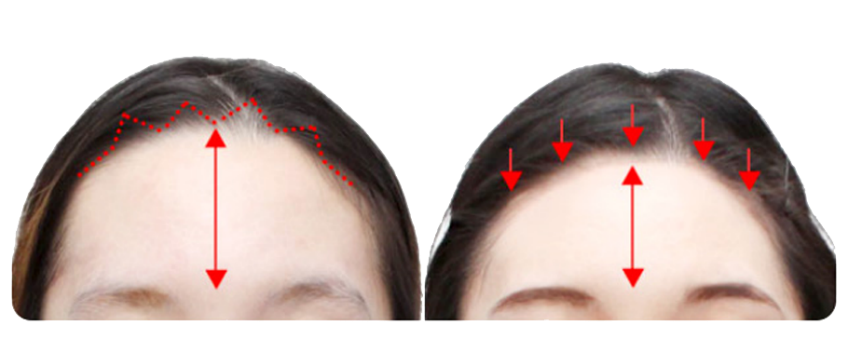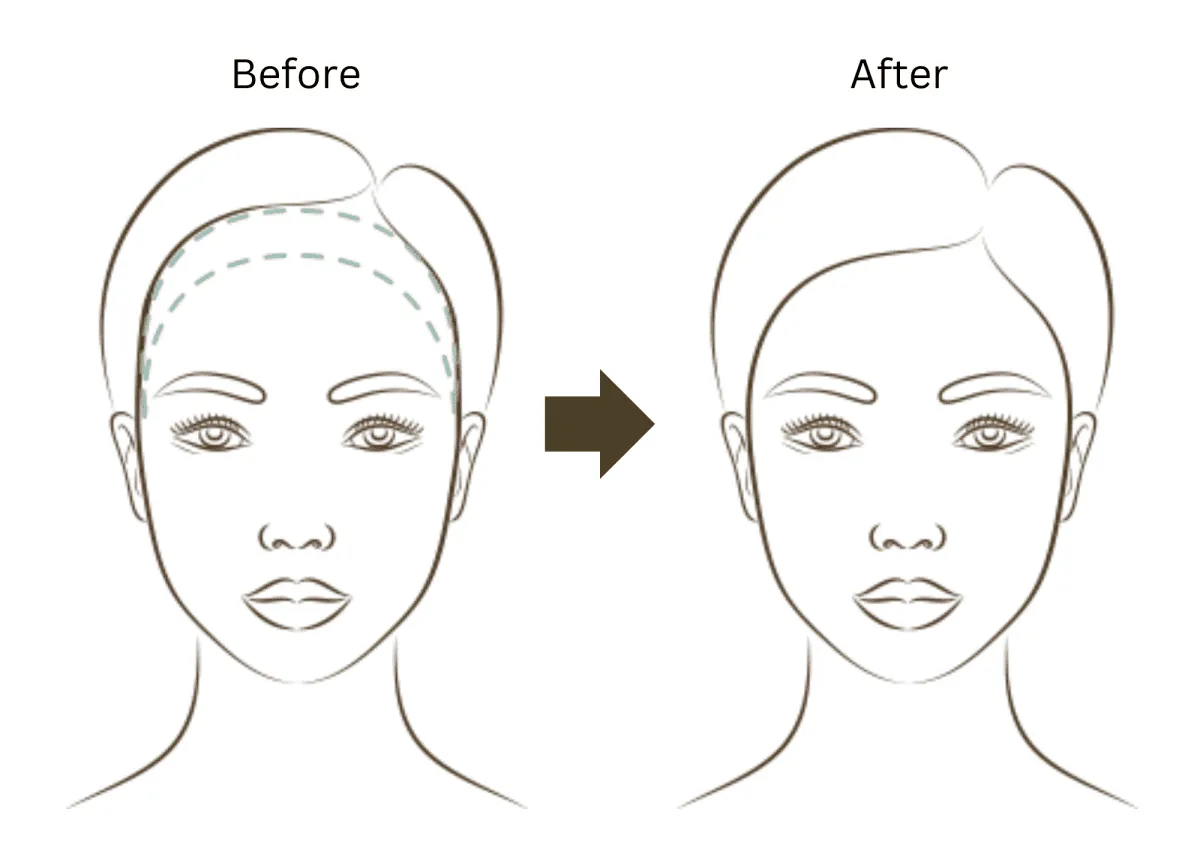
Content

Forehead reduction offers a solution for cases where the forehead is wider than ideal, either congenitally or due to factors such as genetics, stress, aging, illnesses, accidents, or medication use. A wide forehead can negatively affect facial symmetry and proportions, thereby impairing aesthetic appearance.
When the hairline starts from far back, the individual may feel a constant need to cover their forehead. Attempting to conceal this with bandanas, bangs, or hats can be both inconvenient and provide only temporary solutions. This condition can be especially distressing for women. Excessive forehead width can be corrected through forehead reduction surgery or hair transplantation techniques, helping the person achieve a more aesthetic and attractive appearance.
What Is Forehead Reduction?
Also known as forehead minimization, forehead reduction refers to bringing the forehead to ideal proportions by either transplanting hair or surgically removing excess forehead skin. A wide forehead disrupts facial harmony and proportion. An overly exposed forehead can make a person appear older and less aesthetically pleasing.
Why Is Forehead Reduction Necessary?
Individuals who are unhappy with the appearance of a wide forehead often try to cover it using accessories or hairstyles like hats, bandanas, or bangs. These methods are limiting and provide only short-term solutions. However, with the development of modern techniques, narrowing a wide forehead is quite achievable. Whether surgical or non-surgical, these procedures offer comfortable and permanent solutions to attain an ideal forehead appearance.
What Are the Methods of Forehead Reduction?
| Method | Description |
|---|---|
| Forehead Reduction Surgery | Narrowing of the forehead by removing excess skin and pulling the hair-bearing scalp downward. Performed under general anesthesia and provides permanent results. |
| Reduction with Hair Transplantation | Transferring grafts taken from the donor area to the forehead using the FUE method. Performed under local anesthesia and leaves no visible scars. |
Who Is Forehead Reduction Surgery Suitable For?
- Individuals who do not want to fill the excessively wide forehead area with hair transplantation or are not suitable candidates for hair transplantation
- Individuals who are over the age of 18
- Women who are not pregnant or breastfeeding, or who have completed these periods
- Individuals without chronic illnesses or a risk of allergic reactions
- Patients who have completed cancer treatment and fully recovered
- Individuals without infections, wounds, or acne in the forehead area

Who Is Suitable for Forehead Reduction with Hair Transplantation?
Individuals who are not eligible for forehead reduction surgery, those who do not wish to undergo surgery, or those who are concerned about surgical scars can opt for forehead reduction via hair transplantation. By lowering the hairline through transplantation, a natural and aesthetic appearance can be achieved without surgical scars.
Preoperative Preparation for Forehead Reduction Surgery
- The individual is examined to assess the deformity and determine surgical eligibility.
- Regularly used medications are reviewed by the doctor. Medications such as blood thinners are discontinued 7 days prior to surgery.
- Smoking and alcohol consumption should be stopped; plenty of water should be consumed and a healthy diet followed.
- If there are wounds or infections in the forehead area, they should be treated before the surgery.
How Is Forehead Reduction Surgery Performed?
Forehead reduction surgery is performed under general anesthesia in an operating room. The area of excess skin planned for removal is marked and excised. The hairline is lowered to the desired position, and stitches are placed in a way that hides them within the hairline. The operation takes approximately 2 hours.
Postoperative Care for Forehead Reduction Surgery
- The patient stays in the hospital for one night.
- Stitches are removed after 7 days.
- The forehead must be protected from impact.
- The patient should lie on their back with their head elevated.
- The face should not be washed for the first 3 days; hot showers and steam environments should be avoided.
- Direct sun exposure and cosmetic products on the forehead area should be avoided.
- Strenuous activities should be avoided.
- Swelling, redness, and bruising may occur; cold compresses can be applied.
- Dressings should not be neglected, and doctor’s instructions must be followed.
Forehead Reduction Prices
The cost of forehead reduction varies depending on factors such as the method to be applied, the size of the area, the materials to be used, whether hospital stay is required, and the experience of the doctor. Individuals who wish to undergo forehead reduction can visit our clinic to learn the most suitable method and price for their case.
How Is Forehead Reduction Performed with Hair Transplantation?
Forehead width can be reduced non-surgically using the hair transplantation method. Hair follicles taken from the donor area are individually transferred to the predetermined hairline under local anesthesia. The FUE technique is commonly used for forehead reduction. This technique is quick to apply and leaves no scars on the scalp. It provides a natural appearance and is completed in a single session (4–6 hours).
Forehead reduction performed with hair transplantation reaches its ideal appearance within 6–8 months. The hair begins to grow densely and healthily from a lower point on the forehead, eliminating excessive forehead exposure. The person achieves an aesthetic and well-proportioned facial appearance.
Before and After Forehead Reduction
| Condition | Before | After |
|---|---|---|
| Forehead Width | Excessively wide, disproportionate | Ideal proportions, aesthetic |
| Hairline | Hair starting far back | Lowered, natural hairline |
| Facial Aesthetics | Aged and unbalanced appearance | Youthful, proportionate, and symmetrical face |
Can Forehead Reduction Be Applied to Men?
Yes, effective solutions such as forehead reduction surgery or hair transplantation can also be offered to men with a wide forehead. The most suitable and functional method is determined during consultation based on the individual's needs and preferences. Hair loss is quite common in men over time. For those who may experience recession in the frontal hairline, a strategic approach is taken to minimize the visibility of surgical scars during forehead reduction planning. This ensures a natural and aesthetic result.
Where Should the Hairline Be?
The hairline (frontal hairline) is the point where the forehead and hair meet. Depending on genetic traits and facial characteristics, the hairline starts at different points for each individual. If the hairline is higher than it should be, facial balance and proportions are disrupted. To achieve the intended facial expression and aesthetic harmony, the forehead needs to be brought to its ideal width. The most suitable hairline position is determined by the physician during examination, and the appropriate treatment method is identified.
How Is Forehead Height Determined?
Forehead height is determined by considering three factors: the golden ratio of the face, the person's age, and hair density. By evaluating these, the ideal position of the forehead line is established. The doctor plans the new hairline taking into account the individual's age, potential future hair loss, and overall facial proportions. Given the complexity of these elements, forehead height should only be evaluated by professional and experienced physicians.
How Is the Hairline Placement Planned?
To determine the placement of the hairline, a measurement is taken from between the eyebrows to the hairy part of the scalp. This area typically spans about 7 cm. The amount of recession is identified during this process. The movement of forehead muscles and facial expressions are also considered. Age-related changes are taken into account during this assessment. Once the location is set, the shape of the hairline is also planned. Factors such as head shape, facial features, bone structure, and existing deformities are considered to decide whether the hairline will be narrow, wide, curved, or straight.
How Is Forehead Reduction Performed in Women with Hair Transplantation?
A wide forehead is generally more noticeable and less acceptable in women than in men. A broad forehead can create an impression of baldness, which may lead to a negative self-image. As facial proportions are affected, women may struggle to achieve their desired aesthetic appearance. This can lead to loss of self-confidence and emotional distress.
Forehead reduction with hair transplantation is a commonly performed procedure in women. It is a non-surgical and practical method. Healthy hair follicles are taken from the donor area using the FUE technique and implanted into channels opened in the forehead region. Depending on the level of forehead recession, the hairline can be brought forward by 1–3 cm. As a result, a permanent and natural forehead appearance can be achieved painlessly in a single session, with fast recovery and minimal discomfort.

Frequently Asked Questions (FAQ)
Why Does Forehead Height Increase?
Forehead height can increase due to various reasons such as genetic traits, aging, medication use, illness, or accidents. Individuals experiencing this can achieve more aesthetic and proportionate facial features through forehead reduction surgery or hair transplantation.
Is Forehead Reduction Permanent?
Forehead reduction (both surgical and non-surgical) provides permanent results. After the procedure, the individual achieves an ideal forehead width and a balanced, aesthetic facial expression that lasts.
What Does the Hair Look Like After Forehead Reduction with Hair Transplantation?
After hair transplant-based forehead reduction, the forehead achieves an ideal width. The person can style their hair as desired. Since the procedure leaves no scarring, a natural and aesthetic appearance is achieved.
Where Are the Grafts Taken From in Forehead Reduction?
In hair transplants performed for forehead reduction, grafts are taken from the patient’s own healthy and strong hair follicles, usually from the nape area. Depending on the technique used, the donor area is shaved. In the DHI method, the donor area remains unshaven, whereas in the FUE method, it is shaved. With FUE, full shaving is not necessary—only the small area from which the grafts will be harvested is shaved.
Does Forehead Reduction Surgery Leave a Scar?
In forehead reduction surgery, the incision is made along the hairline. As long as the individual does not experience significant hair loss, the scar remains hidden and is not visible. However, if hair loss occurs in the future, the scar may become visible. For this reason, hair transplantation is preferred for men with a high risk of hair loss.
When Will New Hair Grow After Forehead Reduction via Hair Transplantation?
Following the transplant, the implanted grafts undergo shock loss within 14–30 days. All transplanted grafts fall out, and new, healthy hairs gradually grow in their place. New hair growth typically occurs within 4–8 months. After one year, the individual can achieve the ideal forehead width and hair density.
Is It Possible to Reduce the Forehead at Home Naturally?
It is not possible to reduce forehead size naturally at home. While natural products may temporarily help those in the early stages of hair loss, if significant hair loss has already occurred, the only effective solutions are forehead reduction surgery or hair transplantation. It is not possible to change the position of the hairline without surgery or transplantation.
![dr.leyla-arvas-800×1000.jpg[1] dr.leyla arvas](https://www.quartz.com.tr/wp-content/uploads/2024/11/dr.leyla-arvas-800x1000.jpg1_.webp)
Author : Op. Dr Leyla ARVAS
Dr Leyla Arvas is an internationally recognised specialist in aesthetic surgery based in Istanbul. Graduated in 1998 from Istanbul University Faculty of Medicine, she has developed her expertise by studying in Taiwan, Japan and Spain during her 20 years of experience.
This article April 13, 2025 was updated on
Editor: admin@quartz.com.tr


